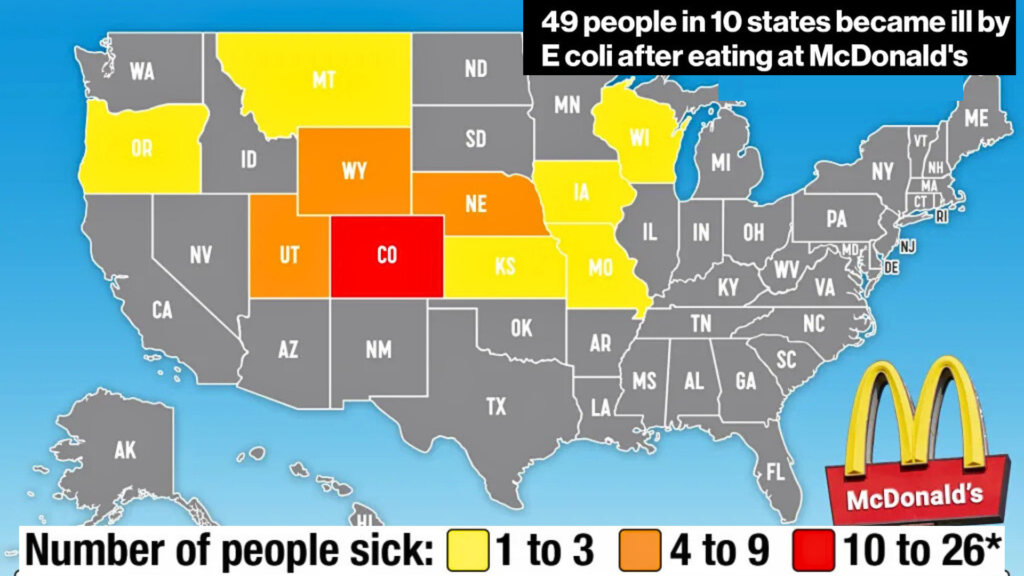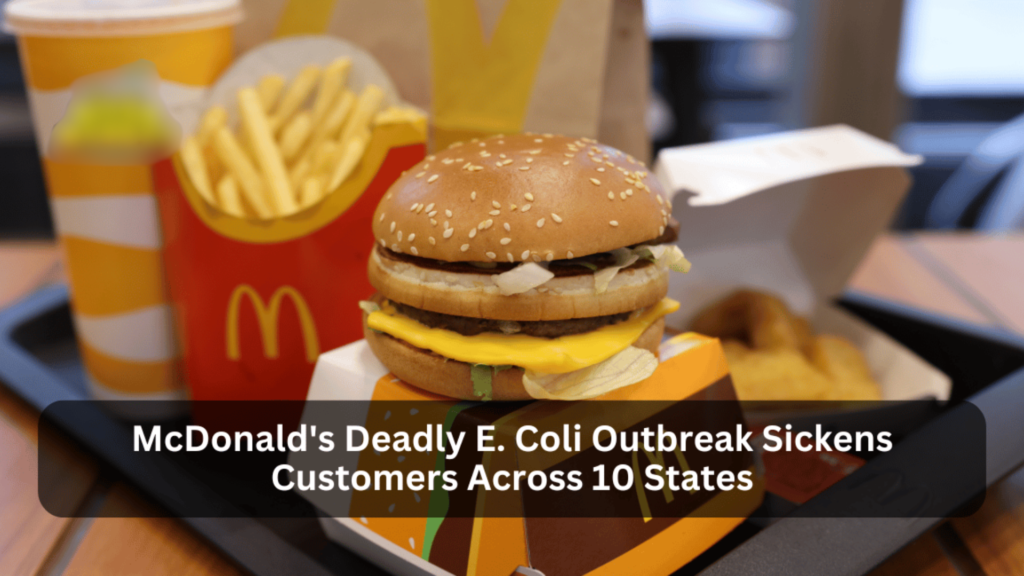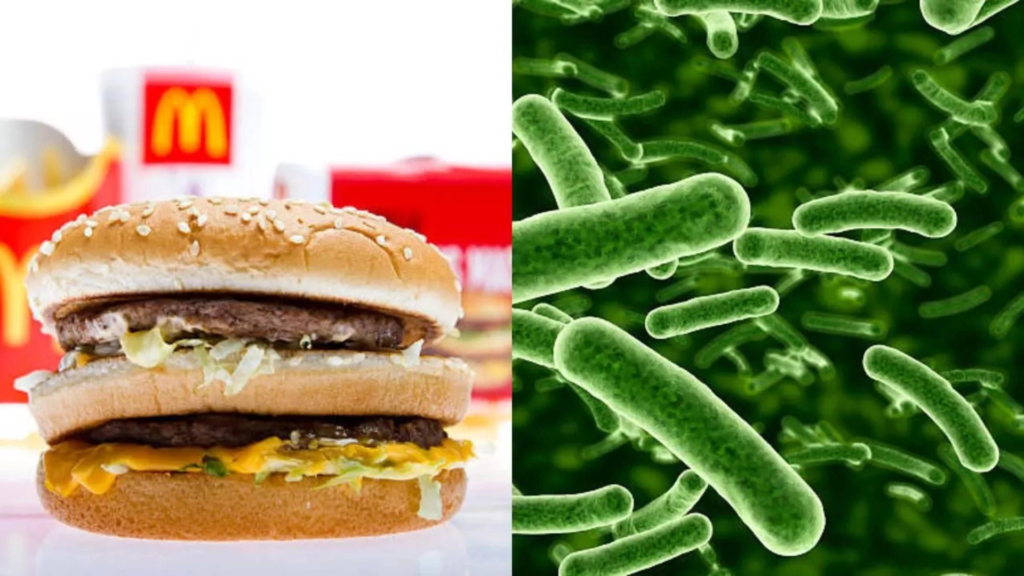America’s most popular fast food chain is facing criticism after a deadly E. coli outbreak linked to one of its most popular menu items, the Quarter Pounder, has spread across 10 states.
This McDonald’s Deadly E. coli outbreak has reportedly sickened 49 customers across several states, with the Centers for Disease Control and Prevention (CDC) confirming that the outbreak has led to 10 hospitalizations and at least one death.
As the investigation continues, questions about food safety in major restaurant chains, the impact of contaminated ingredients, and the response from public health agencies have been at the center of concern. McDonald’s and public health officials are working together to contain the outbreak and prevent further illness. Here is a detailed explanation of what we know.
McDonald’s Faces E. Coli Outbreak Across 10 States
The E. coli outbreak tied to McDonald’s was first reported when customers started experiencing severe gastrointestinal symptoms after consuming Quarter Pounders from various locations.
What started as isolated incidents quickly spread across 10 states, leading to a large-scale investigation by the CDC, local health departments, and McDonald’s corporate offices. State health officials initially noticed the outbreak in states including Colorado, Kansas, Utah, Wyoming, Idaho, Iowa, Missouri, Montana, Nebraska, Nevada, New Mexico, and Oklahoma, with most cases coming from Colorado and Nebraska.
McDonald’s has reportedly been cooperating closely with public health authorities to identify the source of the contamination. However, this outbreak points out the challenges of managing food safety in big, nationwide restaurant chains.

49 Reported Cases and One Death Confirmed
As of October 24, 2024, there were 49 reported cases of E. coli infections connected to McDonald’s, with young children and the elderly among the affected people.
State and local public health officials interviewed people about the foods they ate the week before they got sick. 18 people said they ate at McDonald’s within a few days of falling ill. Sixteen people reported eating a beef hamburger, and twelve confirmed ordering the Quarter Pounder.
Sadly, one person died from the infection, and the public’s attention has been drawn to the outbreak and McDonald’s response. For those who were admitted to the hospital, the symptoms have been severe, from abdominal cramping to dehydration and, in some cases, kidney complications.
According to the CDC, the nature of symptoms in this outbreak has raised concerns about the type of E. coli strain involved. E. coli is a bacteria commonly found in the intestines of humans and animals. While some strains are harmless, others, like E. coli O157, can produce toxins that cause severe illness or even death. Testing is, however, ongoing to identify the specific strain causing this outbreak.
ALSO READ: Ex-McDonald’s Chef Gives Recommendations of Food To Either Try or Avoid at Its Restaurants
Quarter Pounder Ingredient Suspected in Outbreak
The investigation so far has identified a specific ingredient in McDonald’s Quarter Pounder as the likely source of contamination. At first, ground beef was the primary suspect due to its history as a high-risk food product for E. coli contamination.
However, other ingredients, like lettuce, tomatoes, and slivered onions, have also been scrutinized. Health authorities are mainly focused on determining whether the source of contamination is limited to one ingredient or if multiple ingredients are contributing to the spread of the bacteria.
Link Between Slivered Onions and E. Coli Outbreak
While the investigation is ongoing, there appears to be a connection between the onions in the Quarter Pounders at McDonald’s and the outbreak. In essence, the slivered onions used in the Quarter Pounder could be a potential carrier of the E. coli bacteria.
McDonald’s has since issued the following statement: “A subset of illnesses may be linked to slivered onions used in the Quarter Pounder and sourced by a single supplier that serves three distribution centers.”
The said supplier has since been questioned about their storage, handling, and packaging processes, and samples have been sent for bacterial testing as authorities work to identify the exact point of contamination.

In the meantime, Quarter Pounders have been removed from menus in Colorado, Utah, Wyoming, Kansas, and portions of Idaho, Nebraska, Nevada, Iowa, Missouri, Montana, New Mexico, and Oklahoma.
Meanwhile, McDonald’s has temporarily stopped using slivered onions and beef patties in the states affected as the investigation continues. They are also working to make supply changes to prevent the outbreak from spreading further.
E. Coli in Beef Products: Not an Isolated Incident
It is not uncommon for E. coli outbreaks to occur in beef products. Beef products are well-known carriers of E. coli bacteria, especially strains like O157, which can survive undercooked conditions.
Given the popularity of burgers, fast food chains, including McDonald’s, face a huge risk of E. coli contamination in ground beef products. The bacteria often live in cattle intestines, and contamination may happen during the stages of slaughter or processing if proper precautions are not taken.
Earlier this year, Walmart recalled six beef products due to an E. coli outbreak. Boar’s Head was also forced to suspend more than 207,000 pounds of deli meat.
Understanding E. Coli Symptoms and Risks
E. coli’s common symptoms and risks include severe abdominal cramps, diarrhea (often bloody), nausea, vomiting, and fatigue. These symptoms usually appear within three to four days of contact with the bacteria, with the severity varying depending on the strain and the individual’s health.
Also, most people recover within a week without treatment. Still, in more severe cases, it can lead to complications like hemolytic uremic syndrome (HUS), which can cause kidney failure to occur, especially in young children and elderly people.
The CDC recommends seeking medical attention for anyone experiencing severe symptoms or if symptoms worsen after three to five days. Prompt medical attention can help manage symptoms, prevent complications, and save lives.

CDC Recommends Medical Attention for Severe Cases
As previously stated, the CDC has issued warnings to the public, urging anyone who has eaten a Quarter Pounder or similar menu items from McDonald’s and is experiencing symptoms to seek medical attention immediately.
E. coli infections can worsen quickly, and complications like dehydration, kidney damage, and organ failure are potential risks if not treated as soon as possible. Health officials are trying to trace the outbreak while monitoring hospitals for any new cases.
CDC officials have also encouraged those affected to report their symptoms to local health departments. This way, health officials hope to gather more information on the symptoms and locations of the outbreak and identify any other potential hotspots for contamination.
ALSO READ: 7 Fast Food Chains That Always Use Frozen Burger Patties and 5 That Don’t
Walmart and Other Retailers on High Alert
With the extensive use of shared suppliers in the food industry, Walmart and other major retailers are reviewing their stock of similar ingredients, mainly onions, to prevent additional cases.
Walmart has been closely monitoring the CDC updates, ensuring that it, too, prevents any possible contamination in its supply chain. Even though Walmart products haven’t been linked to illnesses, this proactive measure helps prevent the outbreak from worsening.
Other fast-food chains and grocery retailers are taking additional precautions, as they frequently share suppliers with McDonald’s. Many are considering pausing orders of slivered onions and other suspect ingredients until more conclusive test results are available.
How Consumers Can Stay Safe
Consumers must stay informed and cautious about recent developments during this time. The CDC has recommended that consumers avoid eating Quarter Pounders and related food items from McDonald’s locations in affected states.

Additionally, individuals should exercise extra caution when handling and preparing beef at home. Ground beef should be cooked thoroughly to an internal temperature of at least 160°F to reduce the risk of E. coli contamination.
If you experience any symptoms linked to McDonald’s Deadly E. coli outbreak, seek medical advice and inform your healthcare provider of the recent outbreak to ensure appropriate testing and treatment.

